If you know the back story behind the new divisive space opus Interstellar you could easily assume all the schmaltzy stuff came from when it was going to be a Steven Spielberg film and all the clinical 2001: A Space Odyssey pretension is the work of big ole emotionless robot Christopher Nolan. You can’t be Close Encounters of the Third Kind and 2001 at the same time, or so goes a common criticism of the film. Interestingly, though, SlashFilm actually got a hold of the Interstellar’s original script, and it turns out that Nolan out Spielberg-ed Spielberg.
A production history delayed by Paramount and Dreamworks’ messy divorce
Interstellar began its life as a Spielberg project to be produced by Lynda Obst (Contact, another obvious influence on the film) and executive-produced by, oddly enough, an actual astrophysicist, Kip Thorne. They aimed to make a realistic space-exploration film that also applied theoretical physics as accurately as we currently understand them, grounding concepts like black holes and wormholes in something close to hard science. To help them turn these ideas into a screenplay they turned to Jonathan Nolan (Person of Interest, The Dark Knight), a space travel nut who was deeply dismayed about the United States seemingly giving up on NASA. It was his idea to go the dystopian route, positioning NASA as humanity’s last hope in a time when the Earth (via a second Dust Bowl) finally decides to expel its unruly human tenants after centuries of abuse.
That’s all fine and good, but real life intervened when Spielberg’s production company Dreamworks jumped ship from Paramount to Disney in 2009, leaving Interstellar behind. Now, they needed a new director, and luckily their screenwriter just happened to be brothers with the man who’s most recent 3 films (Dark Knight, Inception, Dark Knight Rises) grossed a combined $2.88 billion worldwide.
Christopher Nolan swoops in to save the day – Here begins light spoilers

Now, Interstellar has finally arrived, and it is easily the most sentimental of Nolan’s career, to the point that there are those who might cynically suspect that the film’s focus on the father and daughter dynamic between Cooper and Murph must be a holdover from Spielberg’s time on the project. After all, that’s kind of Spielberg’s jam. Well, we’ll never actually know what Spielberg’s version of this movie would look like, but thanks to SlashFilm.com we do at least know what the script looked like before Christopher Nolan joined. It turns out all of the heart in the original film was mostly going to derive from Cooper and Dr. Brand’s (Anne Hatheway) relationship. Plus, it desperately needed someone to come in and iron it out.
Here are 15 differences between the pre-Christopher Nolan script and the finished product – Here begins the HUGE spoilers
1. It’s not an anomaly in Murph’s room that leads Cooper to NASA but instead a fallen space probe
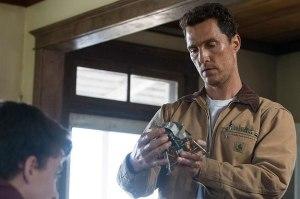
Original Script: Other than the gender, Murph is exactly the same, and the sequencing of events is similar but different. The Yankees game is not interrupted by a dust storm, but instead a bright blue streak in the sky, signaling a satellite falling to Earth. The malfunctioning farm equipment belongs to neighboring farmers, and they are not drawn to Cooper’s house by any kind of gravity anomaly. Once at the neighbor’s farm, Cooper discovers an old NASA space probe which has fallen to earth. When he hacks into it, he finds a strange image of an ice-covered planet as well as a bunch of confusing computer code. Before he can scrap it for parts, the probe begins emitting a loud alarm, only stopping when facing certain directions. Cooper realizes this is some kind of homing beacon, and he and Murph use the family plane to follow the beacon to its destination, which turns out to be a large uninhabited island in Santa Cruz. They are quickly detected and detained by Amelia Brand and TARS.
2. There were no Lazarus missions
Film: At NASA, Cooper and Murph are informed there is a wormhole near Saturn which they have sent probes into as well as a series of manned missions in search of habitable planets in a new galaxy. This was called the Lazarus Mission, and the 12 scientists who went into the wormhole were to transmit data back to Earth and wait to someday be rescued. NASA is mounting a mission to go back to the wormhole and investigate the most promising planets on the other side, and Coop is recruited as a member of the mission due to his piloting skills. Murph doesn’t want him to go, and refuses to say goodbye.
Original Script: NASA had not yet moved beyond sending probes into the wormhole. In fact, the probe which Cooper discovered was the first one to make it back to Earth. After Cooper helps the NASA scientists decipher part of the code on the probe, it’s decided that his engineering capabilities would make him useful on their first manned mission to the wormhole. Coop initially declines before changing his mind, with Murph begging to go with him.
3. Michael Caine’s Elderly Professor Brand is a minor character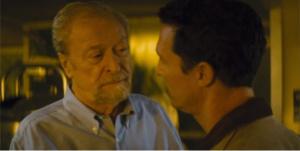
Original Script: Coop has never met Brand before, and though he is the head scientist at NASA Brand actually yields leadership to an Air Force human-sized robot named CASE.
4. The Abyss-esque moment during the trip through the wormhole is much more involved
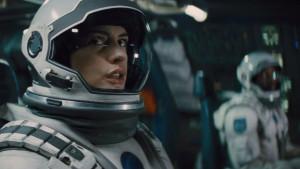
Original Script: The wormhole is a far more narrow expanse to traverse, forcing the ship to carry its nuclear engines on a tether. Once in the wormhole, things get very James Cameron. At first, the crew sees images of themselves through the ship’s outer hull, and then Cooper notices a distortion pushing its way into the hull of the ship, appearing like something out of The Abyss. Doyle sticks his hand up into this sphere above them, temporarily causing his hand to appear mangled. The sphere exits the hull after it examines each crew member.
5. They get pulled into the blackhole immediately, causing TARS to sacrifice itself
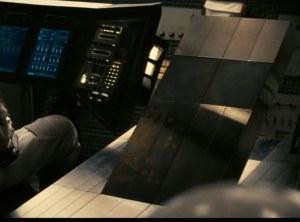
Original Script: As soon as they exit the wormhole, they are pulled into the event horizon of a black hole. TARS saves them by locking himself in the engine compartment and detonating the engine to help buck the ship out of the event horizon. TARS is ultimately sucked into Gargantua, a much bigger black hole.
6. There’s only 1 planet to explore, not 3
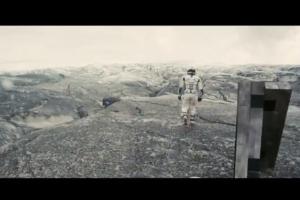
Original Script: There were no Lazarus Missions, and there are no other planets. There is simply the ice planet the scientists learned about from the space probe Cooper discovered. The data they deciphered indicated the planet is 90% frozen water and 10% rock with lots of pockets of oxygen. To reach the surface, they have to navigate through hundreds of tiny moons hurtling around the planet.
7. China beat us to it
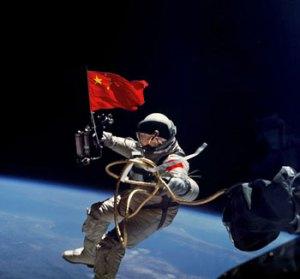
Original Script: There is no water planet, but on the ice planet they discover that China’s actually been there for 30 years, although no one from their secret four person, 15 robot mission appears to have survived. It turns out that in addition to orbiting a black hole the planet is also orbiting a neutron star, which rains radiation down on the planet 4 hours a day. The crew discovers this literally 5 minutes before the neutron star’s daily dose of radiation is to begin, and in a panicked effort to escape via a mine shaft the Chinese crew had been digging CASE cracks a hole in the ice beneath them, dropping them to a far more habitable surface “created by tiny organisms trapped in the ice that absorb the x-rays and emit light and oxygen to the atmosphere below.”
They discover a huge fortified structure which the Chinese robots created in anticipation of the Chinese government transporting human survivors to the planet, which never happened. Eventually, the robots discovered another black hole which was going to upset everything enough to cause the ice planet to be sucked into its nearby black hole. So, the robots somehow left the planet and returned 5 years later with some new technology which could distort gravity, theorizing that throwing this gravity machine into the black hole could somehow save the planet. Eventually, the robots abandoned that theory and left the planet, leaving the machine behind. The crew loads the gravity machine’s data into the space probes, concluding that controlling gravity will allow them to save Earth.
8. An evil robot instead of a desperate Dr. Mann
Film: Dr. Mann (Matt Damon) actually falsified his data. The ice planet is not habitable at all. However, he couldn’t stand to die there. So, he sent false data in the hopes that eventually someone would come to save him. The crew does not figure this out until pretty much the moment Mann tries to kill Cooper once the two are isolated away from the settlement area.
Original Script: The crew discovers that the apparent jungle underneath the ice is actually a collection of fractal alien life-forms, which Brand takes a sample of. When the crew tries to leave the planet they are attacked by camouflaged Chinese robot marines, programmed to prevent the gravity technology from being stolen. CASE fights off the marines, and, well, things get really convoluted. Their lander won’t fly. So, they turn on the gravity machine to get it in the air, losing Romilly (David Gyasi) in the process. CASE shows up in the lander, but Cooper and Brand don’t because he went back for her after she’d stumbled. Doyle’s piloting of the lander, Star War: Empire Strikes Back-style, saves them from right before they were to be released into the thin atmosphere.
But, wait, there’s another twist. That’s not actually CASE; it’s one of the Chinese robots. They all kind of look the same (would you call that Robotist instead of racist?). Our heroes take the bastard out, but the encounter causes the ship to float closer to the black hole, leaving the crew helpless as it watches decades play out it in fast forward outside their window. They see the ice planet smash apart, sucked into the black hole, and then the wormhole gets sucked in as well. They manage to pull away from the black hole, and dock back at the Endurance, where they think that maybe just 47 Earth years had passed. Cooper and Brand watch the video messages much as they do in the finished film, but eventually the messages stop, the scientists realizing that, actually, 300 Earth years had passed. They stopped receiving messages from Earth because humanity must have died off in those 300 years.
9. No cross-cutting at all
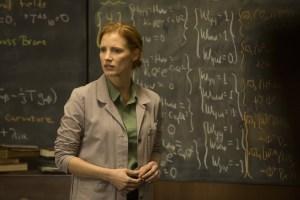
Original Script: Everything is told from Cooper’s point of view meaning that once the story moves to space it stays there. We don’t actually go back to Earth until the very end of the story.
10. Cooper and Brand fall in love and join the zero-gravity sex club

About to have zero gravity sex, the two suddenly remembered there was still another member of their crew left, and he just announced how much he likes to watch
Film: Brand is in love with one of the three Lazarus Mission scientists, even though she knows he’s likely dead. She’s not initially fond of Cooper, but as the mission progresses they become close, so much so that his eventual descent into a blackhole is part of a self sacrifice to spare her life. However, their’s is a relationship far from consummated.
Original Script: Since there were no Lazarus Mission scientists, there isn’t anyone else Brand was hung up on before meeting Cooper. So, distraught after the ice planet and whole “We might be the last humans left” realization, they have sex in zero gravity. Oddly enough, zero gravity sex was a concept once proposed to be used in Jason X.
11. They find a second wormhole

Original Script: Coordinates found in the Chinese crew’s logs reveals a second wormhole close to the black hole. The crew, now just Coop, Brand, and Doyle, escape into the wormhole where they are surrounded by nothing but whiteness everywhere for days.
12. The wormhole creatures return, use gravity to communicate
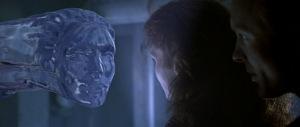
Original Script: The crew again encounters those orb distortions, which are most likely creatures that can only interact using. The things propel the crew through the cabin, and Brand manages to communicate with them. These mysterious beings then guide the ship out of the wormhole.
13. The fifth dimension is not love; it’s an actual dimension
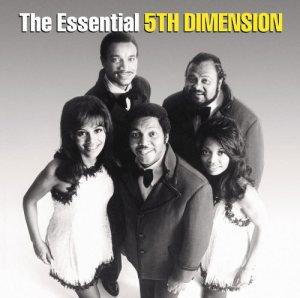
It is not, however, the band 5th Dimension
Film: Brand gives a big speech about the possibility of a fifth dimension being love (or something), which is again echoed by Cooper once he’s in the wormhole and needs the quantifiable power of love to be able to contact the adult Murphy at just the right moment in time.
Original Script: Once outside of the wormhole, the crew sees the entire universe as a flattened disc, realizing they are now outside of space and time, looking from some kind of fifth dimension. They discover a massive space station overlooking it all, encountering TARS who explains how he ended up there (mostly floated, got lucky) and how this is actually where the Chinese robots ended up. The robots were mapping the entire universe, discovering millions of wormholes, hoping to find some way to allow all of humanity to escape Earth.
14. Time travel is less wibbly-wobbly Doctor Who, yet still pretty complicated

Original Script: The Chinese discovered a wormhole which can transport you to an earlier time on Earth, like just a few years after they had originally left. Cooper wants to go in, but Brand argues that time travel is impossible. Even if it is, they would already know if they had actually altered history. Unlike the time travel stories we love, time travel wouldn’t involve creating multiple timelines ala Back to the Future but instead one ever changing timeline. So, they would have already seen evidence that they had altered history, and the videos they’d received from Earth indicated that clearly they failed, time travel or not. She wants to keep searching for another planet; he wants to go in the wormhole. So, they part ways, her in the Endurance and Cooper and Doyle in one of the Chinese ships.
Brand gives Cooper half of the fractal life-forms to take with him, and he also takes one of the space probes with the gravity machine data. Cooper soon realizes this is the same exact probe he found back on Earth at the beginning of the movie. Thinking back to Brand’s explanation of time travel, he deduces that if only the probe managed to make it back through time and on Earth then something must have gone wrong. He tells Doyle this, but he’s having none of it, locking Cooper in the lander and taking the probe and Chinese ship into the wormhole on his one. Stupid Doyle. He dies when his ship can’t handle the wormhole, but the probe makes it through, landing on Earth just as it had before.
For the first time since Cooper left his family behind, the story switches points of view to Cooper’s son Murph, now 30-years-old and working on the farm. The NASA probe landed on Earth just as it did before, but no one was able to decipher the extra data on it, unaware that it was the key to unlocking the mystery of gravity. When Murph heads to NASA in search of some needed spare parts for farm equipment he discovers the probe just sitting in a corner. He then spends years tinkering with it himself, eventually aided by his 18-year-old daughter Emily, who accidentally blows up the house in one of their experiments with the probe.
15. Cooper does still survive, but it’s, again, a bit more complicated
Film: Cooper is expelled from the black hole, coming out somewhere near Saturn many years later (though mere minutes to him). He is rescued by a nearby space station occupied by humans, and manages to say goodbye to an elderly Murph (Ellen Burstyn) on her death bed, surrounded by Coop’s many descendents. On Murph’s advice, Cooper steals one of the space station’s exploration vessels to go through the wormhole and try to find Brand in the other galaxy, where she has discovered a completely habitable planet. Time is distorted there, though, meaning not much time will have passed for her from the last moment she saw Cooper. End of movie.
Original Script: The time-traveling wormhole delivers Cooper and the lander back to Earth in the year 2320, two hundred years after he left. The planet is a barren wasteland. Cooper finds the remnants of his old home just in time for a nasty ice storm to come along and kill him. He fails to make it back to his ship, accidentally dropping his container of fractal lifeforms in the process. It appears as if he will die as the last human on Earth.
Cut to black, and Cooper wakes up in a hospital bed in a huge space station, having been discovered on Earth by space rangers. Later on, an old man visits him in the space station, and it turns out to be his great-great-grandson. The man can no longer speak, but he manages to hand Cooper the watch he had given his son Murph when he left.
After that emotional exchange, Coop is berated by a bureaucrat who explains that the fractal creatures he accidentally dropped had completely overtaken Earth, giving it the appearance of a glowing mass of ice. When Cooper asks to join in the space station’s exploration fleet, he is turned down, informed that most of those positions are occupied by robots now with very little need despite the considerable supply of willing human applicants. Cooper is again rejected when he simply asks for a ship to go in search of Brand, but pretty much exactly as he does in the movie he steals a ship anyway, ending the story on his way to see about a girl.
—
It’s always fun to look back at scripts and compare to finished products, but it’s usually an unfair act since the most extreme elements of the script would have surely been excised and the story brought into a clear focus with subsequent re-writes, possibly from other writers. Jonathan Nolan’s version of this movie does not really seem like the movie Steven Spielberg was going to make. It kind of seems like something that someone who was pissed at America for abandoning space travel and envious of China’s space exploration program would write. It’s actually admirable that with China being such a hugely important market for box office that he would position them (or their robots) as the quasi-villains of the movie. However, it all comes off a tad bit too confusing. I just wrote this whole article, and, frankly, I’m still actually a little confused by some parts of Jonathan Nolan’s story. Then again, if you’re not a fan of some of the more Doctor Who-like elements Christopher Nolan brought to it Jonathan did seem to try to stick a little closer to science, albeit while adding in several kinds of alien lifeforms.
What about you? Which Nolan version of Interstellar do you prefer – Christopher or Jonathan? Or do you wish you could just mix and match? Let me know in the comments.
Source: SlashFilm.com

